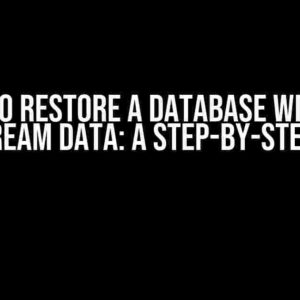Are you struggling with read timeouts in your Cassandra 4.1 database? Do you find yourself lost in a sea of configuration options and uncertain about how to optimize your read performance? Fear not, dear reader, for this article is here to guide you through the process of setting up read timeouts for a simple use case in Cassandra 4.1. By the end of this tutorial, you’ll be well on your way to enjoying blazing-fast read performance and minimizing those pesky timeouts.
What is a Read Timeout, Anyway?
Before we dive into the nitty-gritty of configuring read timeouts, let’s take a step back and understand what they are and why they’re important. In Cassandra, a read timeout refers to the maximum amount of time the database will wait for a response from a node before returning an error to the client. This timeout is critical because it ensures that your application doesn’t hang indefinitely waiting for a response from a slow or unresponsive node.
In a typical Cassandra deployment, read timeouts are essential for maintaining a responsive and resilient system. By setting a reasonable read timeout, you can prevent your application from stalling and ensure that it remains available even in the face of node failures or network issues.
Configuring Read Timeouts in Cassandra 4.1
Now that we’ve covered the basics, let’s get started with configuring read timeouts in Cassandra 4.1. There are several ways to set read timeouts, and we’ll explore each of them in detail.
Method 1: Using the cassandra.yaml File
The simplest way to configure read timeouts is by editing the `cassandra.yaml` file. This file is located in the Cassandra configuration directory and contains a plethora of configuration options.
read_request_timeout_in_ms: 10000
In this example, we’ve set the `read_request_timeout_in_ms` option to 10000 milliseconds, or 10 seconds. This means that Cassandra will wait for up to 10 seconds for a response from a node before returning a timeout error.
Method 2: Using the Cassandra Java Driver
If you’re using the Cassandra Java driver to interact with your database, you can configure read timeouts programmatically. Here’s an example:
import com.datastax.driver.core.Cluster;
import com.datastax.driver.core.Session;
import com.datastax.driver.core.QueryOptions;
Cluster cluster = Cluster.builder()
.addContactPoint("localhost")
.withQueryOptions(new QueryOptions().setReadTimeoutMillis(10000))
.build();
Session session = cluster.connect();
// Perform a read operation
ResultSet rs = session.execute("SELECT * FROM my_table");
In this example, we’ve created a `Cluster` object and specified a read timeout of 10 seconds using the `withQueryOptions` method. We’ve then connected to the Cassandra cluster and performed a read operation using the `execute` method.
Method 3: Using the CQL Shell
Another way to configure read timeouts is by using the CQL shell. You can set the read timeout for a specific session or globally for all sessions.
cqlsh> CONSISTENCY LOCAL_QUORUM;
cqlsh> SET READ_TIMEOUT 10000;
In this example, we’ve set the consistency level to `LOCAL_QUORUM` and the read timeout to 10 seconds using the `SET READ_TIMEOUT` command.
Best Practices for Configuring Read Timeouts
Now that we’ve covered the various ways to configure read timeouts, let’s discuss some best practices to keep in mind when setting up your read timeout strategy.
- Start with a reasonable default timeout: A good starting point for your read timeout is 5-10 seconds. This allows for a decent amount of time for the database to respond while preventing your application from stalling indefinitely.
- Tune your timeout based on your workload: Depending on your workload and application requirements, you may need to adjust your read timeout accordingly. For example, if you’re performing complex queries or dealing with high-latency networks, you may need to increase your timeout to ensure that the database has sufficient time to respond.
- Monitor your timeouts and adjust as needed: Keep a close eye on your read timeout errors and adjust your timeout settings accordingly. If you’re experiencing frequent timeouts, it may be a sign that your timeout is too low or that there’s an underlying issue with your database or application.
- Use a combination of timeouts and retries: In addition to setting a read timeout, consider implementing a retry mechanism to handle transient errors. This can help prevent your application from failing due to temporary issues with the database.
Common Pitfalls to Avoid
When configuring read timeouts, it’s essential to avoid common pitfalls that can impact your Cassandra performance and reliability.
- Setting the timeout too low: Setting the read timeout too low can result in frequent timeouts and errors, even if the database is functioning correctly. Be sure to strike a balance between responsiveness and allowing sufficient time for the database to respond.
- Setting the timeout too high: On the other hand, setting the read timeout too high can lead to long delays and decreased responsiveness. This can be particularly problematic in real-time applications where timely responses are critical.
- Not monitoring timeout errors: Failing to monitor timeout errors can lead to undiagnosed issues with your database or application. Make sure to track timeout errors and adjust your timeout settings accordingly.
Conclusion
Configuring read timeouts in Cassandra 4.1 is a critical aspect of ensuring a responsive and resilient system. By following the methods outlined in this article, you can set up read timeouts that meet the unique needs of your application. Remember to start with a reasonable default timeout, tune your timeout based on your workload, monitor your timeouts, and avoid common pitfalls to ensure optimal performance and reliability.
Additional Resources
If you’re looking for more information on Cassandra 4.1 and read timeouts, be sure to check out the following resources:
By mastering the art of read timeouts, you’ll be well on your way to building high-performance Cassandra applications that delight your users and exceed their expectations.
| Timeout Method | Description |
|---|---|
| cassandra.yaml file | Configure read timeout using the cassandra.yaml file |
| Cassandra Java Driver | Configure read timeout programmatically using the Cassandra Java driver |
| CQL Shell | Configure read timeout using the CQL shell |
Remember, configuring read timeouts is just the beginning. By combining timeouts with retries, tuning your timeouts based on your workload, and monitoring your timeouts, you can build a robust and responsive Cassandra application that meets the needs of your users.
Frequently Asked Question
Get the lowdown on Cassandra 4.1 read timeout for a simple use case!
What is the default read timeout in Cassandra 4.1?
The default read timeout in Cassandra 4.1 is 5000 milliseconds (or 5 seconds). This means that if a read operation takes longer than 5 seconds, Cassandra will timeout and return an error.
How can I configure the read timeout in Cassandra 4.1?
You can configure the read timeout in Cassandra 4.1 by setting the `read_request_timeout_in_ms` property in the `cassandra.yaml` file. For example, to set the read timeout to 10 seconds, you would add the following line: `read_request_timeout_in_ms: 10000`.
What happens when a read timeout occurs in Cassandra 4.1?
When a read timeout occurs in Cassandra 4.1, Cassandra will return a `ReadTimeoutException` to the client. This exception indicates that the read operation took longer than the configured timeout and was cancelled.
Can I configure different read timeouts for different keyspaces or tables in Cassandra 4.1?
Yes, you can configure different read timeouts for different keyspaces or tables in Cassandra 4.1 using the `READ_TIMEOUT` property in the `CREATE KEYSPACE` or `CREATE TABLE` statement. For example, to set a read timeout of 10 seconds for a specific table, you would use the following syntax: `CREATE TABLE mytable (…) WITH read_timeout = 10000;`.
How does the read timeout affect the performance of my Cassandra cluster?
The read timeout can significantly impact the performance of your Cassandra cluster. A shorter read timeout can help prevent long-running queries from consuming resources, but may also lead to more timeouts and retries. A longer read timeout can improve query success rates, but may also lead to increased latency and resource utilization.


